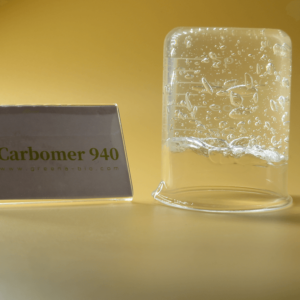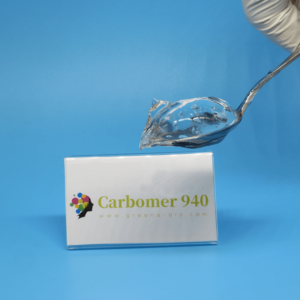1. Gelatinizing Agent
When preparing water-soluble gels, the carbomer concentration is generally selected to be 0.5% ~ 2% according to the viscosity of the required gel. When preparing an emulsion gel, choose a concentration of 1%. When preparing skincare products, the final mass fraction of Carbomer should be controlled to be less than 0.8%, and when it is greater than 0.8%, it is easy to form a film and the skin feel is not good. In order to achieve the desired consistency, Carbomer can also be used in combination with carmellose, sodium alginate, polyethylene glycol, polyvinylpyrrolidone, etc. It can achieve a synergistic thickening effect. Considering the transparency and thickening rate of the gel, the effect of choosing Carbomer 940 is more obvious.
2. Neutralizer
Since carbomer is a fully synthetic polyacrylic acid compound, it contains a large number of free carboxyl groups and is acidic. When the pH value is greater than 4, the carboxyl group begins to dissociate, the polymer swells, and the viscosity increases. When the pH value is 8, the dissociation is basically completed, and the viscosity is maximum. Therefore, a neutralizer (pH adjuster) needs to be added during the preparation of the gel to adjust the viscosity of the preparation. Inorganic alkali neutralizers include sodium hydroxide and potassium hydroxide, and organic alkali neutralizers include triethanolamine, ethylenediamine, lauryl amine, and amine stearate. The more commonly used one is triethanolamine. When carbomer is used as an emulsifier, an inorganic alkali neutralizer and an organic alkali neutralizer can be used for double neutralization. The carbomer neutralized by the inorganic alkali is soluble in the water phase, and the part of the carbomer neutralized by the organic alkali is soluble in the oil phase.
3.Moisturizing Agent
Due to the imperfect storage conditions or packaging, it has been dry and hardened, forming a dry micelle and not easy to spread. The function of adding a moisturizing agent is to maintain the water content of the gel and maintain the stability of the dosage form. Commonly used humectants are glycerol, propylene glycol and other polyols.
4.Stabilizers
The presence of metal ions and strong electrolytes will reduce the viscosity of the gel. At this time, stabilizers can be added to the formula. Commonly used are sodium metabisulfite, citric acid, tartaric acid and EDTA. Generally 0.01% disodium ethylenediamine tetraacetate (EDTA-2Na) solution is used as a metal complexing agent.
5.Preservatives
Gel is a semi-solid preparation, which is easy to be infected by microorganisms, especially in humid environment, adding appropriate amount of preservatives can play a certain role in sterilization or bacteriostasis. Appropriate preservatives should be selected according to different environments, such as sodium benzoate, parabens and ethanol. It is worth noting that the commonly used quaternary amine salts can not be compatible with carbomer. Because carbomer is sensitive to salt and easily causes precipitation.
6.Penetration Enhancers
In order to make the drug in the gel absorb through the skin or mucous membrane and exert its effect better, penetration enhancers are often added to improve drug absorption. Commonly used are azone, oleic acid, oleyl alcohol, ethanol, carbitol, etc.




 Xi'an Greena Biotech Co.,Ltd. is the specialist in the natural products & chemical manufacturer.
Xi'an Greena Biotech Co.,Ltd. is the specialist in the natural products & chemical manufacturer.
